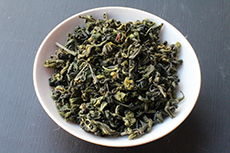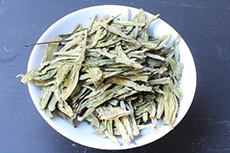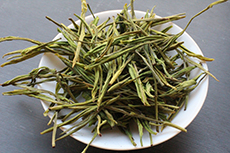.
Search results
Results 1 till 5 of a total of 5 (1 pages).
-
Blog Länggass-Tee
-
Xiao Ye Zhong
-
Fo Xiang Bai Cha
Fo Xiang, Buddha Scent, is a very high quality tea produced in the form of Gunpowder or Chinese Zhu Cha, pearl tea. Just like An Ji Bai Cha it is produced with the leaves of the white leaved tea plant. A really beautiful example for the influence of the tea's form on its taste. Plucked by hand and produced by machine, however artisanally.The producer, who is known in his town as a tea freak, crazy for tea, owns vast tea gardens in the hills around Xinchang and produces a diversity of teas from diverse varietals in good quality.The tea is called Bai Cha, white tea, because the leaves are of a pale green, almost white, when they are plucked, as this tea plant has very little chlorophyll. However, it is produced in the manner of green tea. These tea plants with the whitish leaves had already been described during the Song-dynasty (960-1279), and were ever since thought to be a myth. At the end of the 20th century, however, a wild tea tree of this kind was (re-?)discovered. Teas from this tea varietal are very smooth and incredibly sweet in aroma. Because of the high degree of a certain amino acid in the tea plant these teas have a pronounced umami-taste. -
Bai Ya Long Jing
Baiya Longjing or Baicha Longjing has also been produced from a white-leafed tea plant; but it comes from Xinchang, and not Anxi. It is produced with leaves of the tea plant with the whitish leaves. Exceptional delicacy displaying aromas between An Ji Bai Cha and Long Jing Shi Feng. A beautiful example for the influence of the form on the taste.The producer, who is known in his town as a tea freak, as he is crazy for tea, owns vast tea gardens in the hills around Xinchang and produces a diversity of teas from diverse varietals in good quality.The tea is called Bai Cha, white tea, because the leaves are of a pale green, almost white, when they are plucked, as this tea plant has very little chlorophyll. However, it is produced in the manner of green tea. These tea plants with the whitish leaves had already been described during the Song-dynasty (960-1279), and were ever since thought to be a myth. At the end of the 20th century, however, a wild tea tree of this kind was (re-?)discovered. Teas from this tea varietal are very smooth and incredibly sweet in aroma. Because of the high degree of a certain amino acid in the tea plant these teas have a pronounced umami-taste. -
An Ji Bai Cha
A very famous rarity, which is currently considered one of the best green teas of China. An Ji Bai Cha is a needle-shaped tea (Zhengxingcha) that was roasted in a revolving drum or a shaking machine. This tea is produced by the family of the man who discovered the white-leaved tea bush and they keep the secret of one of the steps in the production (possibly a light rolling) between the roasting in the revolving drums and the shaping in the shaking machine.The tea is called Bai Cha, white tea, because the leaves are of a pale green, almost white, when plucked, resulting from a very small quantity of chlorophyll in the leaf. However, it is produced in the manner of green tea. These tea plants with the whitish leaves had already been described during the Song-dynasty (960-1279), and were thought to be a myth ever since. At the end of the 20th century, however, a wild tea tree of this kind was (re-?)discovered. Teas from this tea varietal are very smooth and incredibly sweet in aroma. Because of the high degree of a certain amino acid in the tea plant these teas have a pronounced umami-taste.
.










